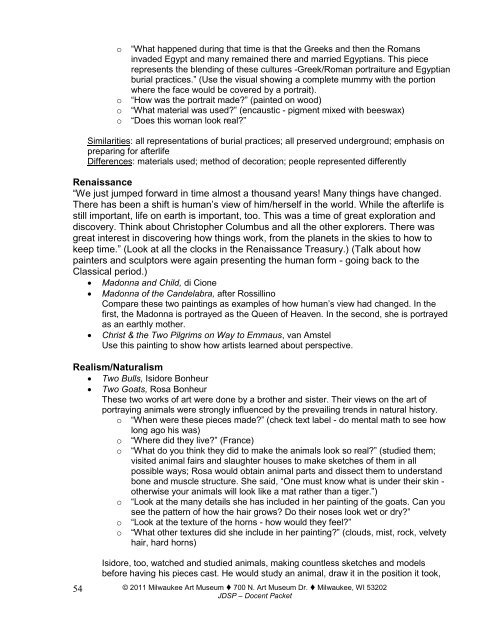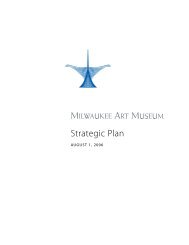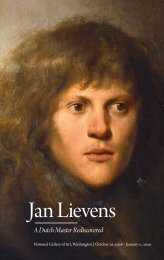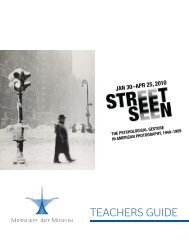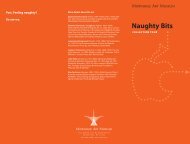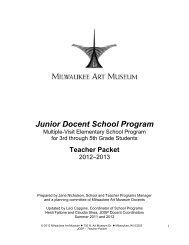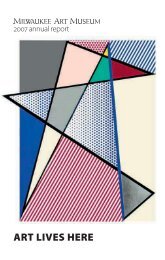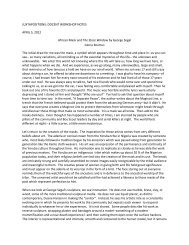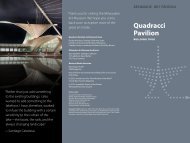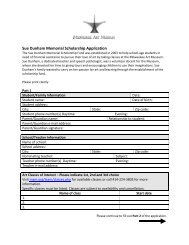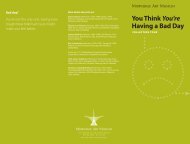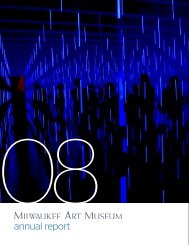Junior Docent School Program - Milwaukee Art Museum
Junior Docent School Program - Milwaukee Art Museum
Junior Docent School Program - Milwaukee Art Museum
You also want an ePaper? Increase the reach of your titles
YUMPU automatically turns print PDFs into web optimized ePapers that Google loves.
o<br />
o<br />
o<br />
o<br />
“What happened during that time is that the Greeks and then the Romans<br />
invaded Egypt and many remained there and married Egyptians. This piece<br />
represents the blending of these cultures -Greek/Roman portraiture and Egyptian<br />
burial practices.” (Use the visual showing a complete mummy with the portion<br />
where the face would be covered by a portrait).<br />
“How was the portrait made?” (painted on wood)<br />
“What material was used?” (encaustic - pigment mixed with beeswax)<br />
“Does this woman look real?”<br />
Similarities: all representations of burial practices; all preserved underground; emphasis on<br />
preparing for afterlife<br />
Differences: materials used; method of decoration; people represented differently<br />
Renaissance<br />
“We just jumped forward in time almost a thousand years! Many things have changed.<br />
There has been a shift is human‟s view of him/herself in the world. While the afterlife is<br />
still important, life on earth is important, too. This was a time of great exploration and<br />
discovery. Think about Christopher Columbus and all the other explorers. There was<br />
great interest in discovering how things work, from the planets in the skies to how to<br />
keep time.” (Look at all the clocks in the Renaissance Treasury.) (Talk about how<br />
painters and sculptors were again presenting the human form - going back to the<br />
Classical period.)<br />
<br />
<br />
<br />
Madonna and Child, di Cione<br />
Madonna of the Candelabra, after Rossillino<br />
Compare these two paintings as examples of how human‟s view had changed. In the<br />
first, the Madonna is portrayed as the Queen of Heaven. In the second, she is portrayed<br />
as an earthly mother.<br />
Christ & the Two Pilgrims on Way to Emmaus, van Amstel<br />
Use this painting to show how artists learned about perspective.<br />
Realism/Naturalism<br />
Two Bulls, Isidore Bonheur<br />
Two Goats, Rosa Bonheur<br />
These two works of art were done by a brother and sister. Their views on the art of<br />
portraying animals were strongly influenced by the prevailing trends in natural history.<br />
o “When were these pieces made?” (check text label - do mental math to see how<br />
long ago his was)<br />
o “Where did they live?” (France)<br />
o “What do you think they did to make the animals look so real?” (studied them;<br />
visited animal fairs and slaughter houses to make sketches of them in all<br />
possible ways; Rosa would obtain animal parts and dissect them to understand<br />
bone and muscle structure. She said, “One must know what is under their skin -<br />
otherwise your animals will look like a mat rather than a tiger.”)<br />
o “Look at the many details she has included in her painting of the goats. Can you<br />
see the pattern of how the hair grows? Do their noses look wet or dry?”<br />
o “Look at the texture of the horns - how would they feel?”<br />
o “What other textures did she include in her painting?” (clouds, mist, rock, velvety<br />
hair, hard horns)<br />
54<br />
Isidore, too, watched and studied animals, making countless sketches and models<br />
before having his pieces cast. He would study an animal, draw it in the position it took,<br />
© 2011 <strong>Milwaukee</strong> <strong>Art</strong> <strong>Museum</strong> 700 N. <strong>Art</strong> <strong>Museum</strong> Dr. <strong>Milwaukee</strong>, WI 53202<br />
JDSP – <strong>Docent</strong> Packet


